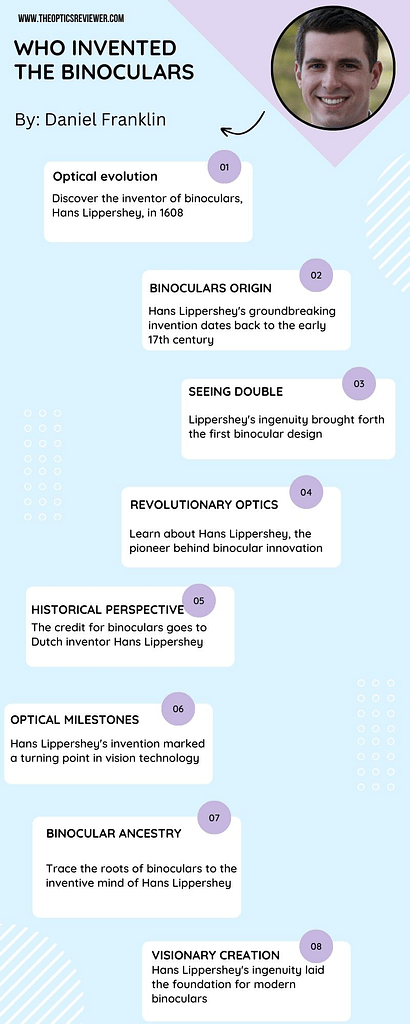Embark on a journey through time to unravel the intriguing tale of Who Invented the Binoculars. In the realm of optical innovation, the creation of binoculars stands as a testament to human curiosity and ingenuity. This narrative delves into the pioneers and visionaries who birthed this revolutionary device, transforming the way we perceive and interact with our surroundings.
From its humble beginnings to the advancements that shaped its evolution, the story unfolds, offering insights into the minds that conceptualized and refined this optical marvel. Join us in exploring the captivating history and uncover the individuals whose inventive spirit brought binoculars to life, forever altering the landscape of observation and exploration.
Contents
- 1 Key Takeaways
- 2 What is the History of Binoculars?
- 3 Who Invented Binoculars?
- 4 When Were Binoculars First Invented?
- 5 What Was The First Binocular Made of?
- 6 Who Invented The First Binoculars?
- 7 What are the Uses Of Binoculars?
- 8 Conclusion
- 9 References
- 10 Frequently Asked Questions
- 10.0.1 How Do Modern Binoculars Differ From the First Binoculars Ever Invented?
- 10.0.2 Are There Any Famous Historical Figures Who Were Known to Use Binoculars?
- 10.0.3 What Are Some Common Misconceptions About the Invention of Binoculars?
- 10.0.4 How Has the Design and Functionality of Binoculars Evolved Over Time?
- 10.0.5 Are There Any Interesting Anecdotes or Stories Related to the Early Use of Binoculars?
Key Takeaways
- The invention of binoculars can be traced back to the early advancements in optics, including the development of reading stones and eyeglasses.
- Collaborations between inventors like Hans Lippershey and the Janssen duo led to significant improvements in lens technology, magnification power, and field of view.
- Innovations such as the Galilean telescope, Porro prism, and optical coatings played crucial roles in the evolution of binocular design and functionality.
- Carl Zeiss’s contributions and the establishment of the Glass Technical Lab in Jena were instrumental in shaping the development and manufacturing of binoculars.
What is the History of Binoculars?
The history of binoculars can be traced back to the concept of reading stones, which were used as early magnifying devices. From there, the journey towards the development of binoculars advanced with the invention of eyeglasses.
With initial improvements, binoculars began to provide a clearer and sharper image, eventually leading to the creation of the first binoculars that could produce an erect image. One notable contributor to this progress was Carl Zeiss, who played a significant role in refining and perfecting binocular technology.

Reading Stones
During the early beginnings of the history of binoculars, an often overlooked development was the invention of reading stones by Vitello, a 13th-century scholar. While the focus is usually on the invention techniques and optical advancements of binoculars, the historical significance of reading stones cannot be disregarded.
These vision aids were small, convex lenses made of glass or crystal that were used to magnify text and aid individuals with poor eyesight in reading. The invention of reading stones paved the way for the development of optical instruments such as spectacles and eventually binoculars. Monk Roger Bacon of the Franciscan order also made contributions to optics, further advancing the field and laying the foundation for the future invention of binoculars.
The Journey Ahead From Eyeglass
Building upon the advancements in optics made by Vitello and Roger Bacon, the next chapter in the history of binoculars began with the collaborative efforts of Hans Lippershey and the Dutch father-son duo, Zaccharias Janssen and Hans Jenssen, who focused their attention on the development of glasses. This marked the beginning of a journey of advancements in lens technology, magnification power, and field of view.
The initial glasses developed by Lippershey and the Janssen duo were primitive compared to modern binoculars, but they laid the foundation for future innovations. Over time, the size and weight of binoculars decreased, while their optical quality and magnification power improved. Today, binoculars find extensive use in various fields such as astronomy, birdwatching, and even military applications, showcasing the remarkable journey from the early eyeglasses to the modern-day binoculars.

Improvements In The Initial Stages
Significant advancements in the early stages of binocular development paved the way for the remarkable journey of this optical instrument. During the 17th century, improvements in optics and advancements in lens technology played a crucial role in enhancing the capabilities of binoculars. Some notable improvements during this period include:
- Galilean Optics: Galileo Galilei constructed the Galilean telescope, which served as the basis for early binocular design.
- New Construction Methods: Astronomer Johann Keppler developed innovative construction methods for telescopes, further improving the design of binoculars.
- Box-shaped Terrestrial Binoculars: Cherubin d’Orleans, Pierto Patroni, and I.M Dobler produced box-shaped terrestrial binoculars, which offered increased magnification and ergonomic design.
- Optical Coatings: In the early stages, researchers began experimenting with optical coatings to reduce glare and improve image quality.
These advancements laid the foundation for future innovations and set the stage for the evolution of modern binoculars.
The First Erect Image
The invention of the Porro prism by Italian engineer Ignazio Porro in 1854 revolutionized binocular technology by allowing for the production of the first binoculars capable of providing an erect image. This optical innovation was a significant milestone in the invention process of binoculars. The Porro prism consists of two prisms placed at an angle of 90 degrees to each other, which helps to correct the inverted image typically produced by lenses.
With the introduction of the Porro prism, binoculars became more versatile and user-friendly, offering a clearer and more natural viewing experience. Over the years, advancements in image stabilization and magnification techniques have further improved the functionality of binoculars. Today, binoculars find applications in various fields such as astronomy, birdwatching, hunting, and even military and surveillance operations. The journey from the first erect image to the modern applications of binoculars showcases the remarkable progress in optical technology.
| Key Features | Description |
|---|---|
| Invention process | The invention of the Porro prism by Ignazio Porro in 1854 |
| Optical innovation | Porro prism allowed for the production of an erect image |
| Image stabilization | Advancements in technology have improved stability |
| Magnification techniques | Ongoing developments have enhanced magnification capabilities |
| Modern applications | Binoculars are used in various fields such as astronomy and birdwatching |
Carl Zeiss
Carl Zeiss, the German optician, scientist, and businessman, played a pivotal role in the early beginnings of binoculars through his revolutionary work in the field of optics. His contributions to the development and manufacturing of optical instruments were instrumental in the manufacturing revolution that took place in the late 19th century.
Zeiss collaborated with Ernst Abbe, a physicist and mathematician, to redesign various aspects of optical instruments, resulting in significant advancements. In 1884, Zeiss, along with his brothers Friedrich and Ernst, founded the Glass Technical Lab in Jena, which further propelled their innovations in optics. The modern binoculars we use today still bear resemblance to the patent application from 1893, showcasing the lasting impact of Zeiss’s work.
Who Invented Binoculars?
In the exploration of the origins of binoculars, it is imperative to understand the pivotal role played by Hans Lippershey, a Dutch eyeglass maker who, in his pursuit to enhance the capabilities of the telescope, applied for a patent for an optical device that would allow for viewing distant objects with both eyes.
Lippershey’s invention, which he presented to the States-General, was described as a device that could make all things at a very great distance appear as if they were nearby when looked at through glasses. This invention was essentially a telescope, but Lippershey aimed to improve it so that it could be used with both eyes.
The invention of binoculars was a result of evolutionary design and optical advancements. Lippershey’s inspiration to create this device came from his desire to enhance the capabilities of the telescope. His invention had revolutionary applications, allowing for the viewing of distant objects with both eyes, which greatly improved visual perception.
The impact of binoculars on visual perception cannot be overstated. They have become an indispensable tool for various activities including birdwatching, astronomy, and even military applications. Lippershey’s invention laid the foundation for the development of modern binoculars, and subsequent inventors like J.P. Lemiere further improved upon his design.
When Were Binoculars First Invented?
The development of binoculars began almost concurrently with that of the telescope, with an optical device patent requested and approved in 1608, albeit on the condition of having two barrels instead of one. This marked the beginning of the evolutionary advancements in binocular technology. However, it was not until the 17th and 18th centuries that binoculars started to take on a more box-shaped design. Despite these early prototypes, they were difficult to handle and lacked high-quality optics.
It was not until 1825 that the first real pair of binoculars was introduced. This marked a significant milestone in the history of binoculars, as it represented a major optical innovation. The introduction of the Porro prism in 1854 and the roof prism in the 1870s further improved the optical capabilities of binoculars.
The year 1894 was another significant turning point for binoculars. It was during this time that the famous glassmaker Carl Zeiss invented a high-quality glass that revolutionized the optical performance of binoculars. This innovation had a historical significance as it greatly enhanced the clarity and precision of binoculars.
The impact of binoculars on surveillance technology cannot be overstated. The ability to observe distant objects with enhanced clarity and detail has made binoculars an indispensable tool in various fields such as military, law enforcement, and wildlife observation. Binoculars continue to evolve and improve, with advancements in technology and materials further enhancing their capabilities. If interested you can read more about what is field of view in binoculars.
What Was The First Binocular Made of?
The first binoculars were made of a combination of lenses and prisms, carefully crafted to achieve a magnified and stereoscopic view of distant objects. The materials used in the construction of early binoculars were primarily glass, as it was the most suitable material for producing lenses with the necessary optical properties. Ancient optical devices such as the magnifying glass and the telescope served as the foundation for the development of binoculars. Early designs of binoculars consisted of two telescopes mounted side by side, allowing each eye to view the same object simultaneously. However, these early binoculars were bulky and heavy, making them difficult to handle and transport.
Advancements in lenses played a crucial role in the evolution of binocular technology. The use of compound lenses, which are made up of multiple lens elements, greatly improved image quality and reduced aberrations. In the late 19th century, the introduction of prisms, specifically the Porro prism system, revolutionized binocular design by allowing for a more compact and portable form factor.
Today, modern binoculars utilize a combination of high-quality lenses, prisms, and advanced coatings to enhance image clarity, brightness, and color fidelity. The use of lightweight materials such as magnesium alloys and carbon fiber has also made binoculars more ergonomic and portable. With ongoing advancements in technology, binoculars continue to evolve, providing users with an immersive and enriching viewing experience.
If interested learn more about how far can the best binoculars see.
Who Invented The First Binoculars?
Having explored the materials and advancements that shaped the early development of binoculars, it is now important to delve into the question of who can be credited with inventing the first binoculars. The invention of the binoculars can be attributed to J. P. Lemiere, who devised the first real binocular telescope in 1825. However, it was Ignazio Porro who made significant advancements in binocular technology with his Italian patent for a prism erecting system in 1854.
To further understand the background of these inventors and the impact of their creations, we can consider the following:
- J. P. Lemiere: While not much is known about Lemiere’s background, his invention of the binocular telescope laid the foundation for future developments in this field.
- Ignazio Porro: Porro, an Italian engineer, made significant contributions to the field of optics with his patent for a prism erecting system. This advancement allowed for a more compact and portable design of binoculars.
- Early prototypes: The early prototypes of binoculars were larger and bulkier than the modern versions. However, they provided astronomers with a powerful tool to observe distant celestial objects.
- Impact on astronomy: The invention of binoculars revolutionized the field of astronomy by enabling astronomers to observe celestial objects with greater detail and clarity.
- Modern applications: Today, binoculars are widely used in various fields such as wildlife observation, sports, and military operations. They have become an essential tool for outdoor enthusiasts and professionals alike.
What are the Uses Of Binoculars?
Binoculars are versatile optical devices that are utilized in a range of industries and activities for enhanced visual observation and magnification. Whether you’re an avid birdwatcher, a nature enthusiast, or a sports fan, binoculars can greatly enhance your experience by bringing distant objects closer. They are also commonly used in astronomy, military operations, surveillance, and even by tourists exploring new landscapes.
To give you a better understanding of the various uses of binoculars, here is a table highlighting some of the most common applications:
| Industry/Activity | Uses of Binoculars |
|---|---|
| Birdwatching | Spotting and identifying birds in their natural habitats |
| Hunting | Scanning the surroundings and tracking animals |
| Astronomy | Observing celestial objects and studying the night sky |
| Sports | Getting a closer view of distant playing fields and events |
| Tourism | Exploring landscapes, landmarks, and wildlife from a distance |
When it comes to choosing binoculars, there are various features to consider, such as magnification power, lens diameter, field of view, and image stabilization. Popular brands known for their quality binoculars include Nikon, Zeiss, Swarovski, and Celestron.
To ensure optimal performance, regular maintenance is crucial. This includes cleaning the lenses with a soft cloth, avoiding exposure to extreme temperatures, and storing them in a protective case when not in use.
Conclusion
In the quest to enhance vision, the inventors of binoculars showcased human ingenuity. From Lippershey’s early contributions to the technological advancements of today, the evolution is awe-inspiring. Whether pursuing scientific discovery or enjoying the wonders of nature, the inventors’ vision echoes in every focused lens.
The story of who invented the binoculars is a testament to human curiosity, innovation, and the relentless pursuit of a clearer, closer view into the world around us.
References
- https://link.springer.com/article/10.1007/BF00235723
- https://link.springer.com/article/10.1007/BF00233186
- https://link.springer.com/article/10.1007/BF00237700
- https://link.springer.com/article/10.1007/BF00248796
Frequently Asked Questions
How Do Modern Binoculars Differ From the First Binoculars Ever Invented?
Modern binoculars have evolved significantly from the first ones ever invented. They incorporate optical advancements, resulting in improved clarity and brightness. Additionally, they are lighter and more compact, offering convenience for users. Field of view has also been enhanced, and coating technology reduces glare and improves image quality.
Are There Any Famous Historical Figures Who Were Known to Use Binoculars?
Throughout history, many famous figures have been known to use binoculars for various purposes. From explorers like Lewis and Clark to military leaders like Napoleon, binoculars have played a significant role in their endeavors. Early binoculars had their limitations, but with evolving design and technology, misconceptions surrounding their usage have been debunked. Anecdotes from the past highlight the importance of binoculars in shaping our understanding of the world.
What Are Some Common Misconceptions About the Invention of Binoculars?
There are several common misconceptions surrounding the origins and evolution of binoculars. These misconceptions often overlook the contributions of lesser-known inventors and fail to acknowledge the famous users and anecdotes associated with this remarkable optical device.
How Has the Design and Functionality of Binoculars Evolved Over Time?
Over time, the design and functionality of binoculars have undergone significant advancements. Technological progress has led to improved optical quality, enhanced ergonomics and comfort, added waterproof and fog proof features, as well as magnification and field of view improvements.
Are There Any Interesting Anecdotes or Stories Related to the Early Use of Binoculars?
Early binocular users found various unusual applications for binoculars, including in warfare, exploration, and sports. These versatile optical devices provided enhanced vision and allowed individuals to observe distant targets or surroundings with precision and clarity.

